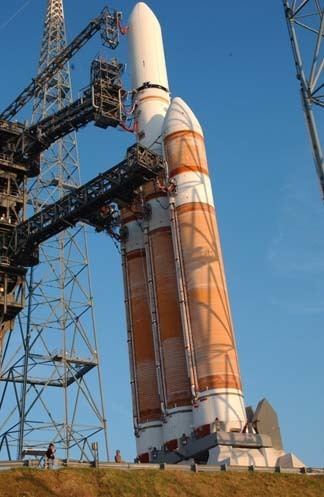 | ||
A modular rocket is a type of multistage rocket which features components that can be interchanged for specific mission requirements. Several such rockets use similar concepts such as unified modules to minimize expenses on manufacturing, transportation and for optimization of support infrastructure for flight preparations.
Contents
Atlas V
The Atlas V expendable launch system uses the liquid fueled Common Core Booster as its first stage. In most configurations a single CCB is used with strap-on solid rocket boosters. A proposed configuration for heavier loads strapped together three CCBs for the first stage. The Common Core Booster utilizes the Russian made RD-180 burning RP-1 fuel with liquid oxygen producing a thrust of 3.8 MN. The liquid propellant tanks use an isogrid design for strength, replacing previous Atlas tank designs which were pressure stabilized.
The length of the common core booster is 89 feet (27 m), and has a diameter of 12.5 feet (3.8 m).
Delta IV
The Delta IV launcher family uses the liquid fuel Common Booster Core as the first stage of the various rocket configurations. One or three modules can be used as the first stage. In most configurations a single CBC is used with or without strap-on SRBs. Three CBCs together form the first stage of the Heavy configuration. The CBC uses the Rocketdyne RS-68 engine and burns liquid hydrogen with liquid oxygen producing a thrust of 2.9 meganewtons (650,000 lbf).
Angara
The Universal Rocket Module (URM) is the modular liquid fueled first stage of the Angara expendable launch system. Depending on the configuration, the first stage can consist of 1, 3, 5 or 7 URMs. Each URM uses a Russian-made RD-191 engine burning RP-1 fuel with liquid oxygen producing a thrust of 1.92 MN.
Falcon Heavy
The Falcon Heavy launch vehicle consists of a standard Falcon 9 v1.1 center core with two additional Falcon 9 v1.1 stretched core stages acting as liquid strap-on boosters. Each core is powered by nine Merlin 1D engines burning rocket-grade kerosene fuel with liquid oxygen producing almost 5.6 meganewtons (1,300,000 lbf) of thrust. The Falcon Heavy is being designed with a unique propellant crossfeed capability, where fuel and oxidizer to power most of the engines on the center core is fed from the two side cores, up until the side cores are near empty and ready for the first separation event.
All three booster cores are planned to eventually be reusable. After the side cores are released, the center engine in each side core will continue to burn for a few seconds in order to control the trajectory of the side boosters.
The propellant crossfeed leaves the core booster two-thirds full of fuel at staging while enabling it to run all engines at full power during the initial ascent, when high thrust is most desirable. This is in contrast to the otherwise similar Delta IV Heavy, which must throttle back its central engine after liftoff in order to conserve the central core's fuel for use after staging. Likewise, compared to a traditional three-stage design, the propellant crossfeed eliminates the "dead weight" of carrying inactive second-stage engines from launch to the first staging event, as well as removing the risk of those engines failing to ignite in flight. The downside to these advantages is added complexity of plumbing.
This staging plan, which could be scaled up to a large number of boosters, comes from a proposed booster design described in a book on orbital mechanics by Tom Logsdon. In the original proposal, a cluster of identical cores would each crossfeed to a neighboring core, with the last pair crossfeeding to the center. Thus, as the rocket ascends, the first pair of cores provide fuel to all the engines, then drop away. The second pair then fuels all remaining engines, and so on. (Pairs are used to maintain symmetric mass distribution.) An engineer named Ed Keith is attributed as the creator, having called the design an "asparagus-stalk booster" from a large cluster's resemblance to a bundle of asparagus. (Logsdon, Tom (1998), Orbital Mechanics - Theory and Applications ).
